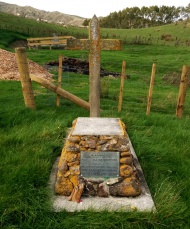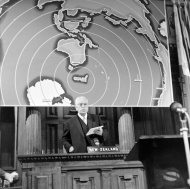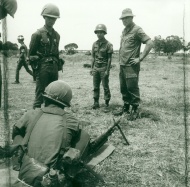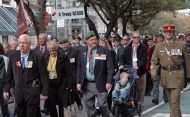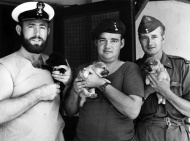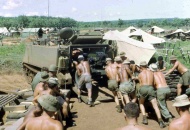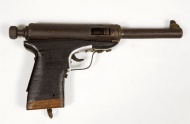Events In History
-
 18 August 1971Deadline for Vietnam pull-out announced
18 August 1971Deadline for Vietnam pull-out announcedPrime Minister Keith Holyoake’s statement in Parliament that New Zealand’s combat force would be withdrawn before the end of the year coincided with a similar announcement by the Australian government. Read more...
-
 12 May 1971Anti-Vietnam War protests in Queen Street, Auckland
12 May 1971Anti-Vietnam War protests in Queen Street, AucklandA civic reception for 161 Battery on its return from Vietnam was disrupted by protesters who accused New Zealand soldiers of being murderers and threw red paint symbolising the Vietnamese blood they had on their hands. Read more...
-
 15 January 1970Anti-Vietnam War protesters greet US Vice President
15 January 1970Anti-Vietnam War protesters greet US Vice PresidentUnited States Vice-President Spiro Agnew's visit to New Zealand sparked violent confrontations outside his hotel between anti-war demonstrators and police. Read more...
-
 19 October 1966New Zealand’s day with LBJ
19 October 1966New Zealand’s day with LBJPresident Lyndon Johnson's 24-hour visit was aimed at shoring up support for the war in Vietnam. Protesters were outnumbered by enthusiastic crowds. Read more...
-
 16 July 1965NZ artillery opens fire in Vietnam
16 July 1965NZ artillery opens fire in Vietnam161 Battery, stationed at Bien Hoa air base near Saigon, opened fire on a Viet Cong position in support of the American 173rd Airborne Brigade. Read more...
-
 25 April 1963NZ medics start work in South Vietnam
25 April 1963NZ medics start work in South VietnamOn Anzac Day 1963, a six-strong New Zealand civilian surgical team arrived in Qui Nhon, South Vietnam as part of the Colombo Plan assistance programme. Their deployment marked the beginning of New Zealand’s involvement in the Vietnam War. Read more...
Articles
Vietnam War

The Vietnam War was New Zealand's longest and most controversial overseas military experience. Although this country's troop commitment and casualties were modest, the conflict aroused widespread protest and condemnation. And for those who fought in Vietnam, it was a tough homecoming.
- Page 1 - The Vietnam WarThe Vietnam War was New Zealand's longest and most controversial overseas military experience. Although this country's troop commitment and casualties were modest, the conflict
Vietnam War tribute 08

Classroom activity ideas for Tribute08 and New Zealand's participation in the Vietnam War
- Page 1 - Vietnam War Tribute 08 social studies activitiesClassroom activity ideas for Tribute08 and New Zealand's participation in the Vietnam
The Cold War

Although the origins of the so-called Cold War can be traced back to the Bolshevik revolution of 1917, this intense ideological struggle between the Western powers and the Soviet Union really began after the Second World War.
-
Page 4 – Treaties and alliances
During the 1940s and 1950s New Zealand signed a series of collective treaties with Britain and the United States aimed at countering the threats of Japanese military resurgence
-
Page 5 – South-East Asia
During the 1950s the focus of New Zealand’s defence strategy shifted from the Middle East to Asia.
-
Page 6 – Protest and dissent
The end of the Vietnam War shifted the focus of the Cold War away from Asia and New Zealand's need for ‘forward defence’ diminished. These changes, together with the anti-
Links - military history

Links to military resources including personnel records, medal winners and war graves.
- Page 5 - Post Second World WarLinks to further information about New Zealand's military participation since the Second World
NZ's Search for Security

Overview, links to related topics and suggested classroom activities for this potential NCEA topic
- Page 3 - Related topicsLinks to topics relating to the Level 1 NCEA theme New Zealand's Search for
The 1960s

Five decades ago most Kiwis enjoyed a standard of living that was the envy of other nations. During the 1960s the arrival of TV and jet airliners shrank our world, and New Zealanders began to express themselves on a range of international issues, including opposition to the Vietnam War.
-
Page 9 – 1966 - key events
A selection of the key events in New Zealand history from 1966
Military mascots

New Zealanders have one of the highest pet-ownership rates in the world. Wartime was no different. Take a tour through this menagerie of military mascots: dogs, cats, donkeys, monkeys, pigs, goats and birds. There's the famous bull terrier Major Major, along with the less well-known, but very cute, slow loris adopted by 1 RNZIR in Borneo.
- Page 4 - Other military mascotsMascots we would like more information about, mainly from post-Second World War
The Royal New Zealand Navy

Seventy years old in October 2011, the Royal New Zealand Navy is today an integral part of the New Zealand Defence Force. But its 1941 establishment was the result of a long process of naval development.
- Page 6 - Post-war operationsLike all the services the RNZN faced difficulties of readjustment to peacetime conditions, not only in drastically reducing numbers but also in determining the shape of the
Biographies
-
 Holyoake, Keith Jacka
Holyoake, Keith Jacka
‘Kiwi Keith’ Holyoake, the first officially designated deputy PM (1954) was our third-longest serving leader.Although criticised for sending troops to the Vietnam War, he is now seen as ‘the most dovish of the hawks’, doing the bare minimum to keep America happy.
Read more...
Related keywords
- cold war
- anzus
- keith holyoake
- prime ministers
- united states
- elsthorpe
- SEATO
- international relations
- wellington city
- walter nash
- weapons
- WW1
- war memorials
- WW2
- niue
- 1960s
- parades
- protest
- nuclear free
- korean war
- navy
- malayan emergency
- royal new zealand navy
- film
- 1970s
- americans
- auckland city
- links
- peacekeeping
- communism
- singapore
- borneo confrontation
- soviet union
- viet cong
- chinese
- national party
- governor-general
- united nations
- flags
- war objects
- mascots
- parliament
- christmas
- peter williams
- artillery
- disasters
- maori leaders
- te atairangikaahu
- television
- king koroki
- kingitanga
- waterfront dispute
- australia
- mount eden prison
- cook islands
- maps
- springboks
- parliament buildings
- poster
- victoria university
-
Main image: Keith Holyoake and Lyndon B. Johnson
New Zealand Prime Minister Keith Holyoake with United States President Lyndon B. Johnson at the White House, 1968.


